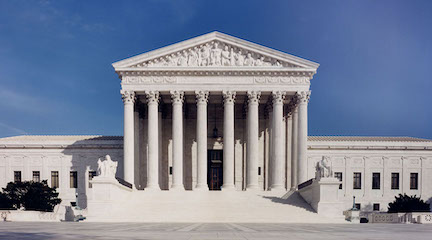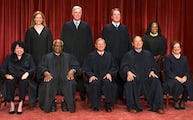Nomination Setting
The nomination setting tracks the political environment at the time when a vacancy on the Court occurs.
For the president, more favorable settings, a positive score, permit greater latitude in
selecting a nominee because the conditions for confirmation are better. Less favorable settings,
negative scores, hold more potential for controversy and potential defeat of a nominee if care
is not taken in finding a nominee acceptable to one's political opposition.
The Setting

The chart here displays the settings for vacancies and subsequent
nominations since President Eisenhower's terms of office. As scores move
away from 0 towards 6 in the positive direction, the
setting becomes more and more favorable for the president and, consequently,
the nominee. As scores move away from 0 in a negative direction, the
setting becomes increasingly unfavorable for the president and the potential
for controversy increases.
We define the setting using four variables, namely, party split in the
Senate, Senate support of presidential positions, presidential popularity
in the public, and vacancy attributes. A specific setting score is derived
by summing the standardized scores for each of the four setting variables.
A downloadable version of a table detailing the data for this chart and
providing the definitions of the variables can be found by clicking on the
chart to the right.
When Obama first assumed the presidency, the potential for controversy was
relatively low. With a Democratic Senate, he had two vacancies to fill and
did so with relative ease. When the Republicans took control of the
Senate for Obama's last two years, the potential for
controversy increased. Of course, whether controversy actually ensues may depend
on who is nominated. The 1986 nomination
of Robert Bork to fill Powell's vacancy ignited a controversy. On the
other hand, the potential for controversy was similar in 1975 when President Ford
appointed John Paul Stevens (Sv) to replace Justice Douglas, a nomination
well-received by the Senate. Only with the Sotomayor and Kagan nominations have we witnessed
controversy where the potential for it seemed rather low. No doubt this reflects the increased
partisan rancor of recent years.
The decision by the Republican majority in 2017 to eliminate the filibuster in order to ensure
the confirmation of Gorsuch and any subsequent Trump nominee has increased the potential
for controversy in situations where the majority party margin is perilous. With the fiibuster in
place, the majority and presumably the president would realize the necessity of having a
nominee capable of appealing to a handful of minority party senators. With a narrow margin,
the opposition party need only persuade enough of the majority
senators to cross over while holding their own in line. When the minority has any realistic
hope of defeating a nominee, controversy will ensue.
| Al | Alito |
| Br | Barrett |
| Bg | Burger |
| Bk | Bork |
| Bl | Blackmun |
| Bn | Brennan |
| By | Breyer |
| Cr | Carswell |
|
| F1 | Fortas 1st |
| F2 | Fortas 2nd |
| Gd | Garland |
| Gn | Ginsburg, D |
| Gs | Ginsburg, R |
| Gb | Goldberg |
| Gr | Gorsuch |
| | |
|
| Hr | Harlan |
| Hy | Haynsworth |
| Kg | Kagan |
| Kn | Kavanaugh |
| Kn | Kennedy |
| Mi | Miers |
| Mr | Marshall |
| | |
|
| Oc | O'Connor |
| Pw | Powell |
| R1 | Rehnquist 1st |
| R2 | Rehnquist 2nd |
| Rb | Roberts |
| Sc | Scalia |
| So | Sotomayor |
| | |
|
| Su | Souter |
| Sv | Stevens |
| Sw | Stewart |
| Th | Thomas |
| Wh | White |
| Wk | Whittaker |
| Wr | Warren |
| | |
|
What if a President ignores the setting?
Presidents who ignore the setting do so at their peril. Reagan could have placed both
Bork and Scalia on the Court if he had nominated them in reverse order. The setting for
the Scalia nomination was quite favorable. Had he gone forward with Bork at that time,
confirmation was virtually assured. Scalia, on the other hand, was a strong nominee for
difficult times, like the setting that actually existed when Bork was nominated. Of course, hindsight . . .
The second President Bush faced a setting that was only slightly more favorable
than the one confronting President Reagan with the Lewis Powell vacancy
in 1987. Even more than O'Connor, Powell was a quintessential swing
vote on the Court that was perceived to be equally divided between four
to the left of center (Marshall, Brennan, Blackmun, and Stevens) and
four to the right (Rehnquist, Scalia, White, O'Connor). Facing a potentially
explosive setting (a -3.6 on our setting table), President Reagan tossed
in a fireball in the person of Robert Bork, a distinguished academic
and jurist who nonetheless would almost surely have joined Scalia and
Rehnquist to form a strong corps of conservative activists
on the Court. The result was a controversial nomination, the likes of
which had not been seen since the nomination of Louis Brandeis in 1916
and which engendered a battle among advocacy groups in opposition and
support that had never been seen. Bork was defeated by a Senate with
a Democratic majority. President Bush faced a similarly negative setting
(a -2.73 on our table) with the O'Connor vacancy, but he had a strong Republican
majority in the
Senate, effectively 55-45, that Reagan did not. Control of the Senate permits a
president to nominate individuals in controversial settings that he otherwise
could not do.
With the nomination of Harriet Miers, Bush underestimated
the passion of the conservatives for replacing O'Connor with someone distinctly
more conservative, especially on those social issues of abortion, religion,
and equal protection on which O'Connor commonly was the fifth vote for
a liberal majority. They had been waiting a long time and had their
hopes dashed before, dating all the way back to the appointment of Justice
Blackmun, who was supposed to be a twin of Chief Justice Burger. The
appointment of Anthony Kennedy after Robert Bork's defeat provided
a less reliable conservative vote. Subsequently, the appointment of David
Souter, the supposedly conservative stealth candidate backfired, resulting
in one who became a solid member of the relatively liberal bloc of
four on the Court. That's why Republicans no longer like stealth candidates
and why the conservatives were not willing to take President Bush at his
word that Harriett Miers would be this strong conservative they so long
for. His follow-up with Samuel Alito was just the person they wanted. His
membership in the Federalist Society helped the credibility of the Federalist
Society as an organization that could be relied on to identify judges with
an originalist jurisprudence and a conservative activism perspective.
The Setting for Biden
Facing an evenly divided Senate, President Biden has no room for error in any of his judicial appointments,
and the Democrats have delivered for him. Even two or three Republicans have been frequently in support
(Collins-ME, Murkowski-AK, Graham-SC). Since the Democrats eliminated the filibuster for judicial nominees
to the district and appeals courts, they need acquire only a majority vote, and Biden has submitted a record
number of nominees in his first year.
The Republicans paved the way for Biden in any Supreme Court nomination, having eliminated the filibuster
for the justices to facilitate the approval of Neil Gorsuch in 2017. Biden should be able to secure the confirmation
of any objectively qualified nominee in the period leading up to the new term of the Court, which begins on the
first Monday in October, prior to the November 2022 midterm election.
But times have changed, Breyer being the last justice to have been confirmed with only single digit opposition
in the Senate in 1994. In 1986, Antonin Scalia was unanimously confirmed, all Democrats voting for him as one
conservative replacing another. Republicans acquiesced to Clinton's appointments of Ginsburg and Breyer with
only 3 and 9 dissenting voices, neither one expected to produce change on the Court and the Republicans lacking
sufficient votes to filibuster either of them.
Update by George Watson on January 30, 2022 |



